Rabbit
Oryctolagus cuniculus
There are more than 300 different species!
Advertisement
Rabbit Scientific Classification
- Kingdom
- Animalia
- Phylum
- Chordata
- Class
- Mammalia
- Order
- Lagomorpha
- Family
- Leporidae
- Genus
- Oryctolagus
- Scientific Name
- Oryctolagus cuniculus
Read our Complete Guide to Classification of Animals.
Rabbit Conservation Status
Rabbit Facts
- Main Prey
- Clover, Grass, Crunchy vegetables
- Habitat
- Forest thickets, meadows and woodland
- Predators
- Foxes, wolves, bobcats, eagles, owls, coyotes
- Diet
- Herbivore
- Average Litter Size
- 6
View all of the Rabbit images!
Rabbits have been domesticated since Roman times, and possibly even from before that.
Rabbits really do breed like rabbits. The female is ready to breed almost any time, and she’ll have a litter of babies about 30 days after breeding. These bipedal herbivores eat a diet of mostly green foods, but they are also opportunistic feeders that will eat seeds, fruit, and bark. They live in large groups in underground tunnels called warrens with anything from a few to dozens of roommates.
See all of our expert product reviews.
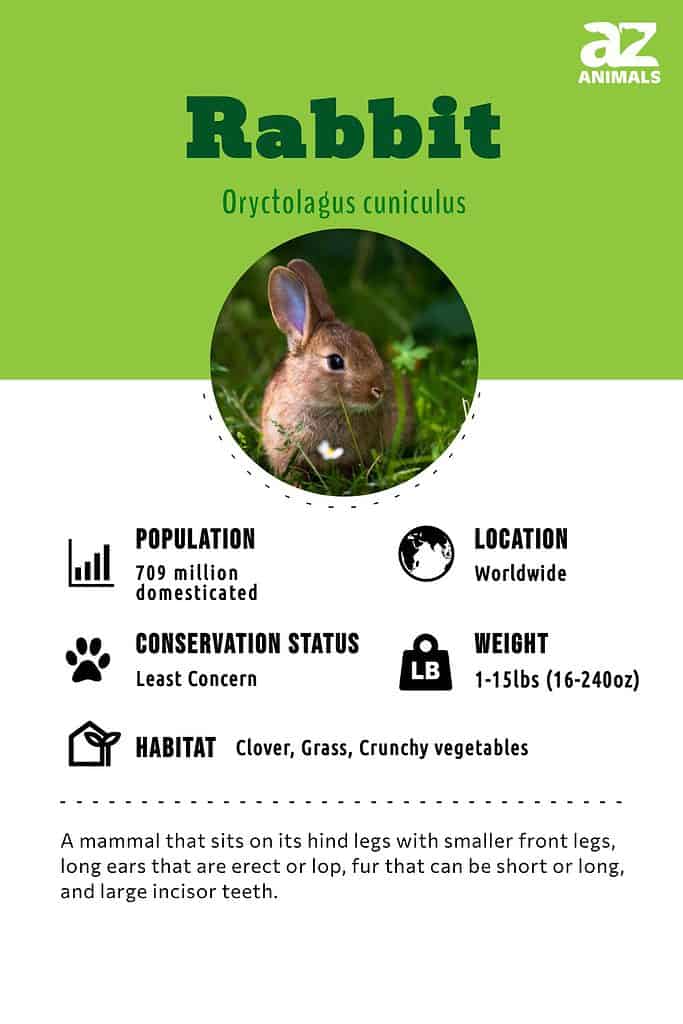
Incredible Rabbit Facts!
1. A rabbit can’t vomit.
2. A rabbit can see nearly 360 degrees around him.
3. Rabbits live in underground tunnels called warrens.
4. Rabbits can jump nearly 10 feet in a long jump.
5. A rabbit’s teeth grow throughout its lifetime.
Scientific Name
The scientific name for these animals depends on what kind of rabbit is being discussed. In general, they belong to the order Lagomorpha and the family Leporidae, while the hare does not. Within that genus are dozens of rabbit names that include the scientific name for the rabbit as a part of the classification.
The taxonomy list includes rabbits such as Oryctolagus cuniculus, the scientific name covering all pet rabbits. In this name, the word Oryctolagus represents the genus name and cuniculus is the species. Some of the other rabbits covered in the taxonomy here include the genus Nesolagus, which covers the Sumatran striped rabbit, Nesolagus netscheri, and the Annamite striped rabbit, Nesolagus timminsi.
It also covers the genus Pentalagus, which includes the Amami rabbit, and Pentalagus furnessi, plus the genus Poelagus, which includes the Central African Rabbit, the Poelagus marjorita. There are many others since we’re talking about more than 300 breeds, but these are a few of the major ones covered by the various classification listings.
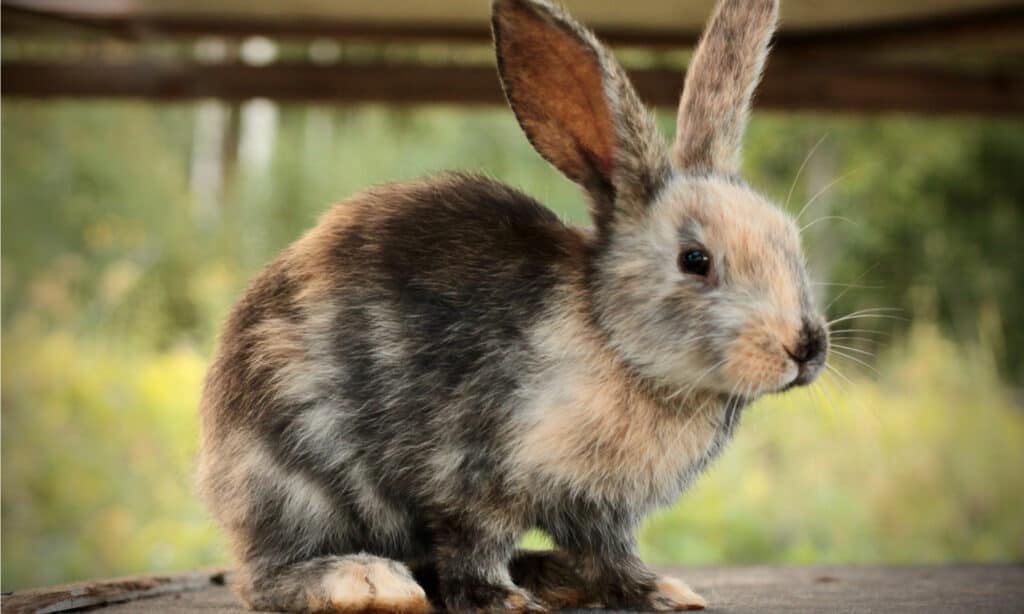
Rabbits belong to the order Lagomorpha and the family Leporidae.
Health and Entertainment for your Rabbit
See all of our expert product reviews.
©LNbjors/Shutterstock.com
Evolution
The oldest known fossil of a primitive rabbit was dated as 55 million years old. The ancestor is named Gomphos elkema. Based on a study of it, scientists believe some early lagomorphs (the group that includes hares and rabbits) moved like rabbits, having hind legs that were longer than their front legs. These hind legs could be used to hop.
These early rodents had longer tails, molar teeth, and primitive jaws. In general, rabbits are distinguished from other modern rodents because they have two sets of incisor teeth, one set behind the other. Rabbits were originally grouped with rodents under the class Glires, but have since been separated because many of their similarities are believed to be the result of convergent evolution. Recent DNA analysis and the discovery of a common ancestor have supported the view that they share.
Appearance
The rabbit’s appearance is an animal that sits on its large hind legs and has shorter front legs. The animal also has large ears that vary in size based on the type. The hare looks similar to the rabbit but is not the same. These ears are used to radiate heat into the air when the animal has been running or is otherwise excited or when it lives in the wilderness and needs to use its ears to maintain its comfort. They can also be turned to listen to sounds to determine where a predator might be coming from or to make sure that an area is safe.
These animals come in a variety of sizes. Pygmy rabbits grow to only eight inches long and weigh in at less than a pound, even when fully grown. Chinchillas are at the other end of the scale, weighing in at about 16 pounds. Most Flemish giants stop at about 22 pounds, but one rabbit, also a Flemish giant, beat all the rest by weighing in at 49 pounds and stretching 4 feet, 3 inches long.
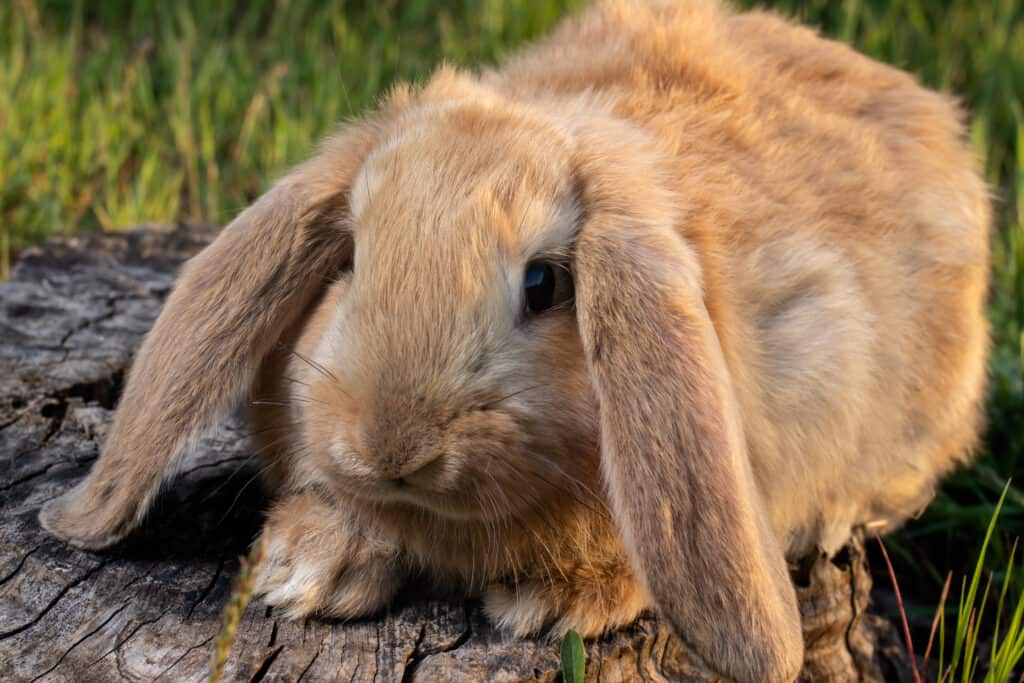
Some rabbit breeds are characterized by lop ears, like the French lop.
©Garna Zarina/Shutterstock.com
Behavior
Rabbit behavior includes using its shape to escape from danger when it needs to. This sometimes means that the animal needs to sit still and sometimes it needs to run. Whatever they choose is also likely to change as the rabbit is hunted, though this depends on what the animal needs at the time.
Rabbits hop by bounds, moving quickly over terrain when they need to escape from predators. They can also freeze in place when they need to. This sometimes results in a failure of the chase, letting the animal go free for another day. It all depends on the situation at the time.
When rabbits eat, they will often graze heavily for the first half an hour or so, then switch to eating their own poop pellets as they are excreted. They need to do this to get the benefit of their food as they eat. Eating partially-digested poop is an important way they accomplish this. They will often take the food from their anuses and chew it again to get the benefit of it. These animals cannot vomit, so if they eat too much of the wrong thing they can end up dying from it.
To know if rabbits are rodents, read here.
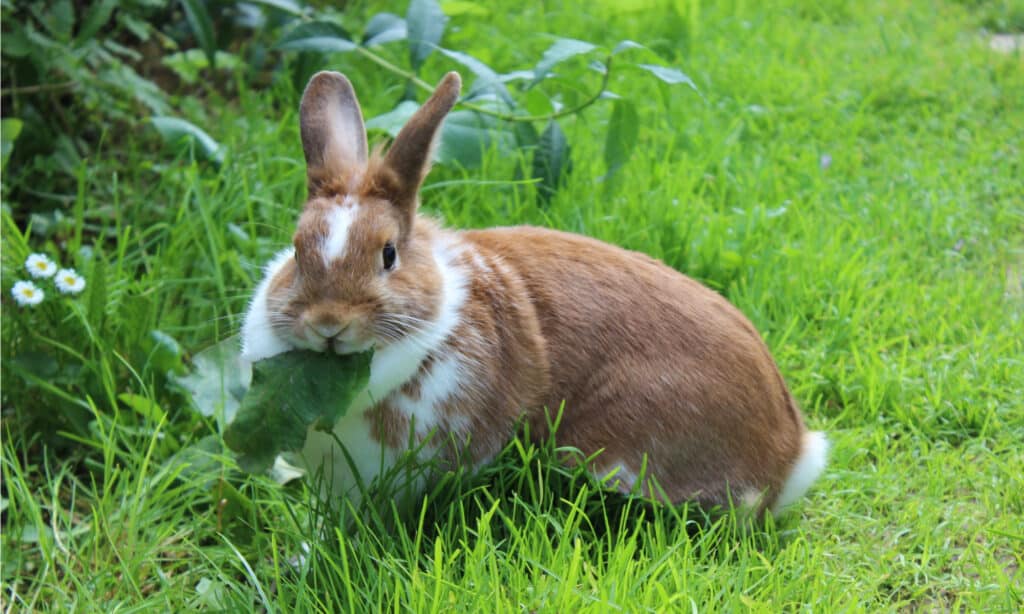
Rabbits usually graze heavily for the first half an hour or so, then switch to eating their own poop pellets as they are excreted.
©Real Moment/Shutterstock.com
Habitat
These animals live in large groups known as warrens, living under the ground in spaces carved out by them as they move in. They typically live in these warrens with a group of other rabbits in meadows, deserts, woods, grasslands, wetlands, or forests. Not all rabbits live in a warren. Some species live out in the open instead.
More than half of the world’s rabbits live in North America, but bunnies are also native to southwest Europe, Sumatra, Southeast Asia, some parts of Japan, and in parts of Africa and South America. They are not normally found in Eurasia or most of South America, though in some cases they may be taken to these places and released.

Rabbits typically live in warrens with other rabbits in meadows, deserts, woods, grasslands, wetlands, or forests.
©Chaturong Krirkkriangkrai/Shutterstock.com
Diet
A rabbit will eat all kinds of soft, grassy foods, including grass, leafy weeds, and forbs. They will also eat fruit, bark, and many other kinds of food that grow in the woods and meadows where they live. They will digest what they can of the food and will then poop out the hard bits in poop that are not eaten. The soft bits are typically pooped out and then eaten again before being done with.
The rabbit digests a lot of its food in the cecum, which takes joins the large intestine to take up about 40% of its digestive tract. The cecum is even bigger than the stomach. The cecum helps to separate the “good” poop from the “bad.” The bad poop is pooped out of the rabbit and the good poop – called cecotropes — is eaten by the bunny and goes back through the rabbit again before being pooped out. While this may seem kind of gross, it is important to the rabbit’s digestive system and is necessary for the animal to survive.
To get the complete details on what rabbits eat, make sure to read our complete guide: ‘What Do Rabbits Eat.‘
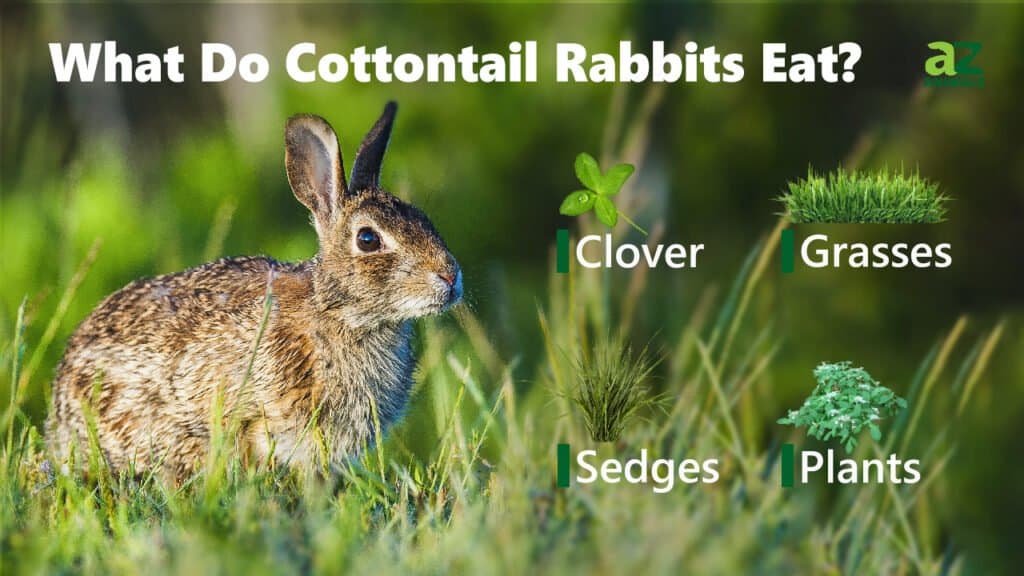
Predators and Threats
Almost everything that eats meat will eat a rabbit if it’s big enough. This includes animals such as foxes, wolves, bobcats, eagles, owls, and coyotes. Any of these animals, and more, are sure to grab a rabbit snack if given a chance to do so.
Bunnies will do what they need to do to survive, including thumping on the ground if they feel threatened. Their eyesight also has a good deal of vision devoted to overhead scanning, helping them to avoid birds. If confronted on the ground they will jump into a burrow if necessary or hop away using a zig-zag pattern. Their big teeth will also help them to bite if they can. If they can escape, they will live to hunt another day.
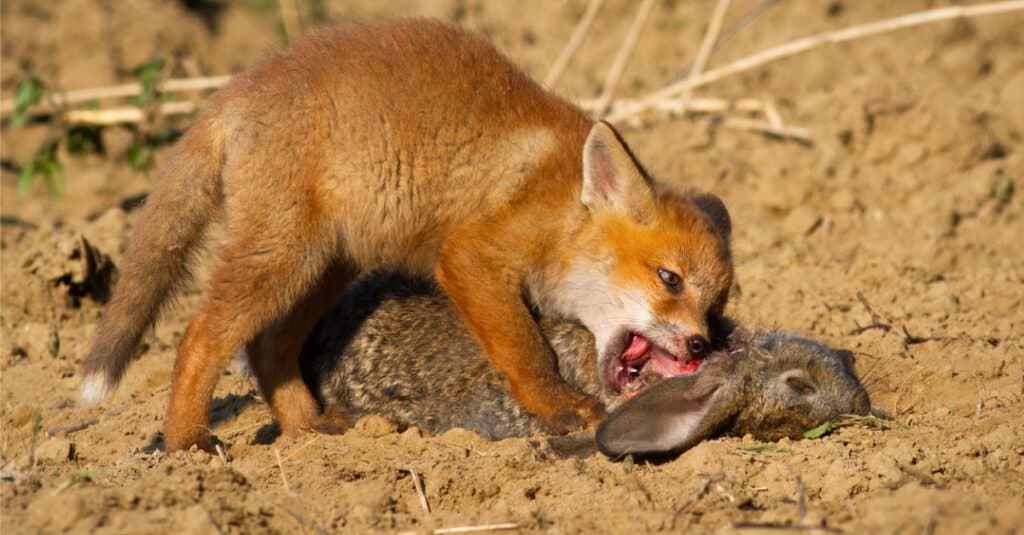
Foxes are predators of rabbits.
©iStock.com/JMrocek
Reproduction, Babies, and Lifespan
Reproduction occurs almost anytime two adults get together since females can get pregnant almost anytime they breed. The male simply climbs on top of the female and breeds her, with no introduction needed. He will breed as many females as he can, but it’s best to give him a break in between breedings so he doesn’t wear himself out.
Once the male, known as the buck, inseminates the female, known as the doe, she will get pregnant and will produce a litter of babies, called kittens or kits, for about 30 days. The mother typically gives birth to six youngsters. The babies are born naked and blind, completely dependent on their mother at first, though within a couple of weeks, they are strong and ready to run around on their own. They live with their mother for about a month before they are ready to move on. By then she is often pregnant again. They are ready to have babies of their own by the time they are about three months old.
The lifespan of a pet bunny can be very long, with the longest-living rabbit known to have died in Tasmania at 18 years old. By contrast, wild animals such as an eastern cottontail live less than a year. Most rabbits that live in captivity can live anywhere from 10 to 12 years, on average.
Rabbits may develop problems along the way, with diseases such as the pathogens Bordetella bronchiseptica and Escherichia coli being common. They can also contract rabbit hemorrhagic disease (RHD), also known as myxomatosis. They are also vulnerable to things such as tapeworms and external parasites including fleas and ticks.

A litter of baby bunnies are called kittens or kits.
©JayOg/Shutterstock.com
Population
It isn’t clear how many of these animals exist in the world today, but they are not threatened. They are listed as being of Least Concern on the A to Z animal website, since in most places where they live their population is stable, and in many places, it is even on the rise. They are capable of living anywhere that humans can live.
Rabbits in places such as Eastern Australia continue to grow despite human efforts to stop them, and the more baby bunnies that get released the faster the population will grow. Once they have gotten started there isn’t much of a way to stop them, so it’s important to think before you release a bunny into the wild.
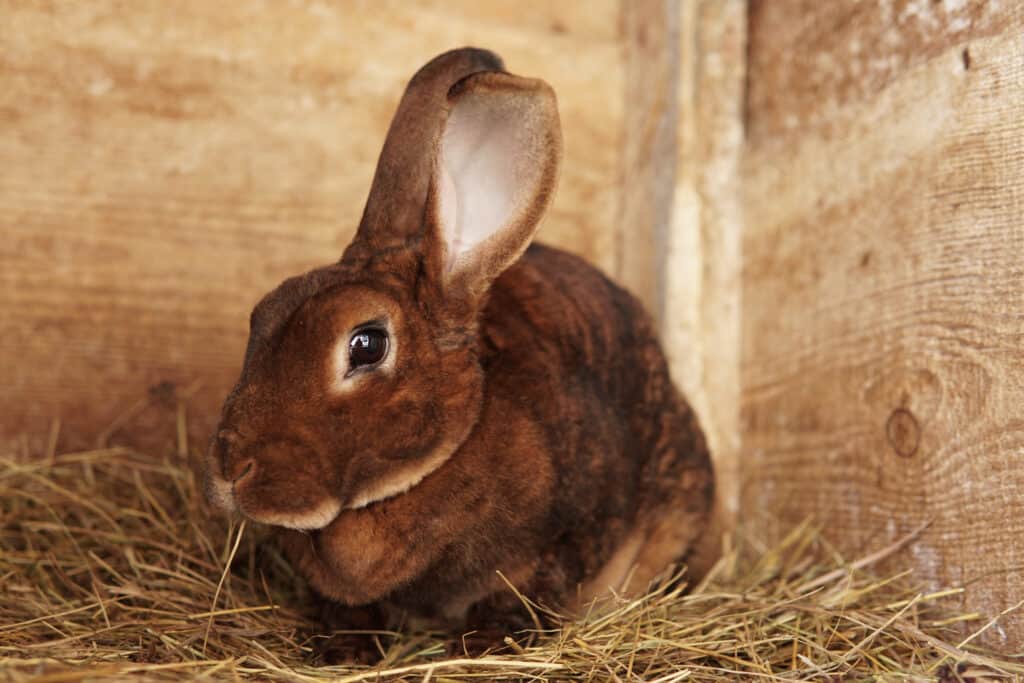
The Rex rabbit, known for its silky fur, is a popular house pet.
©Diana Sklarova/Shutterstock.com
Types of Rabbits
There are at least 305 breeds of domestic rabbits around the world. Below is a list of almost 200 breeds:
- Alaska
- Altex
- American – Native to the U.S. Short blue and white hair, 9-12lbs.
- American Chincilla
- American Fuzzy Lop – Ntive to U.S. Short haired, solid, lop-eared, 3.5-4lbs.
- American Sable
- Angora – Native to Turkey. Has long white angora hair, 4.4-12lbs. One of oldest domestic breeds.
- Argente Bleu – One of the oldest breeds of French show rabbits. Silver top hair with Argente Bleu markings on lower hair shaft.
- Argente Brun [UK] – One of the oldest breeds of French show rabbits. Silver top hair with Argente Brun markings on lower hair shaft.
- Argente Brun [US] – One of the oldest breeds of French show rabbits. Silver top hair with Argente Brun markings on lower hair shaft.
- Argente Clair – One of the oldest breeds of French show rabbits. Silver top hair with Argente Clair markings on lower hair shaft.
- Argente Crème [UK] – One of the oldest breeds of French show rabbits. Silver top hair with Argente Crème markings on lower hair shaft.
- Argente De Champagne [UK] – One of the oldest breeds of French show rabbits. Silver top hair with Argente de Champagne markings on lower hair shaft.
- Argente Noir – One of the oldest breeds of French show rabbits. Silver top hair with Argente Noir markings on lower hair shaft.
- Argente St Hubert – One of the oldest breeds of French show rabbits. Silver top hair with Argente St Hubert markings on lower hair shaft.
- Armenian Marder
- Astrex
- Aurora Negro
- Baladi Black
- Baladi Red
- Baladi White
- Bauscat
- Beige [UK]
- Belgian Hare [UK]
- Beveren [UK]
- Beveren [US]
- Big Silver Marten
- Blanc de Bouscat
- Blanc de Hotot
- Blanc de Popielno
- Blanc de Termonde
- Blue of Ham
- Blue of Sint-Niklaas
- Bourbonnais Grey
- Brazillian
- Brittania Petit [US]
- British Giant
- Brown Chestnut of Lorraine
- Caldes
- Californian [UK] – Native to California. White, short hair with dark points, erect ears.
- Californian [US] – Native to California. White, short hair with dark points, erect ears.
- Canadian Plush Lop
- Carmagnola Grey
- Cashmere Lop – Native to the U.K. Long-haired, lop-eared rabbit between 4.5-5.5 lbs.
- Champagne d’Argent
- Chaudry
- Checkered Giant
- Chinchilla [UK]
- Chinchilla Giganta [UK]
- Cinamon
- Continental Giant Coloured
- Continental Giant White
- Creme d’Argent
- Crillo
- Cuban Brown
- Czech Red
- Czech Solver
- Czech Spot
- Czech White
- Dalmation
- Deilenaar
- Dutch [UK] – Native to U.K. Short-haired rabbit with erect ears and “Dutch” markings, 3.5-5.5 lbs.
- Dutch [US] – Native to U.K. Short-haired rabbit with erect ears and “Dutch” markings, 3.5-5.5 lbs.
- Dwarf Hotot
- Dwarf Lop [UK] – Native to Europe/Germany. Short-haired, lop-eared breed with many colors, 4.25-5.25lbs.
- Enderby Island
- English Angora
- English Lop – Native to U.K. Short-haired, lop-eared breed with many colors, 10-11lbs.
- English Spot
- Fauve de Bourgogne
- Flemish Gian [UK]
- Flemish Giant [US]
- Florida White
- Fox
- Fox-Silver [UK]
- French Angora – Native to France. Long angora hair, erect ears, 7.5-10.5lbs.
- French Lop – Native to France. Short-haired, lop-eared breed with many colors, 10lbs.
- Gabali
- German Angora – Native to Germany. Long angora hair, erect ears, 5.5-12lbs.
- Giant Chinchilla [US]
- Giant Havana
- Giant Marburger
- Giant Papillon [UK]
- Giant Silver
- Giant Smoke Pearl
- Giza White
- Golden Glavcot
- Gotland
- Gouwenaar
- Grey Pearl of Halle
- Güzelçamlı
- Harlequin [UK] – Native to France. Harlequin coloring, short-haired, erect ears.
- Harlequin [US] – Native to France. Japanese coloring, short-haired, erect ears.
- Harlequin Rex – Native to France. Harlequin coloring, short-haired, erect ears.
- Havana [UK]
- Havana [US]
- Himalayan
- Holland Lop [US] – Native to Netherlands. Short-haired, lop-eared rabbit in varied colors, 4-6.5lbs.
- Hulstlander
- Hungarian Giant
- Isabella
- Jamora
- Japanese White
- Jersey Wooly
- Kabyle
- Lilac [UK]
- Lilac [US]
- Lionhead [UK] – Native to Europe. Long mane around face, erect ears, varied colors.
- Lionhead [US] – Native to Europe. Long mane around face, erect ears, varied colors.
- Liptov Baldspotted Rabbit
- Lynx
- Marburger Feh [UK]
- Mecklenburger Piebald
- Meissner Lop
- Mellerud Rabbit
- Mini Lop [US] – Native to Netherlands. Lop-eared, short-haired, 5-6lbs.
- Mini Rex [US]
- Mini Satin [US]
- Miniature Cashmere Lop
- Miniature Lion Lop
- Miniature Lop [UK/NL]
- Miniature Papillon
- Miniature Rex [UK]
- Miniature Satin [UK]
- Moshtohor
- Netherland Dwarf – Native to Netherlands. Short erect ears, short hair, 1-2.5 lbs.
- New Zealand [US]
- New Zealand [UK]
- New Zealand White [UK]
- Nitransky
- Opossom
- Orange
- Orylag
- Ørestad
- Palomino
- Pannon White
- Perlfee
- Plush Lop (Miniature)
- Plush Lop (Standard)
- Pointed Beveren
- Polish [UK]
- Polish [US]
- Rex [US] – Native to France. Short rex hair, varied colors, erect ears, 6-10.5lbs.
- Rhinelander
- Rhone
- SA Phendula
- Sachsengold
- Sallander
- San Juan
- Satin [UK]
- Satin [US]
- Satin Angora
- Schwarzgrannen [UK]
- Separator [DE]
- Siamese Sable
- Siberian
- Silver [UK]
- Silver [US]
- Silver Fox [UK]
- Silver Fox [US]
- Silver Marten
- Simenwar
- Slovenian Rabbit
- Smoke Pearl
- Spanish Giant
- Squirrel
- Standard Chinchilla
- Stone Rabbit
- Sussex
- Swedish Fur
- Swedish Hare
- Swiss Fox
- Tadla
- Tan
- Teddy Dwarf
- Teddy Lop
- Thrianta
- Thuringer
- Tri-Color Dutch
- Tri-Color English
- Trønder
- V-line
- Velveteen Lop
- Vienna Colored
- Vienna White
- Wheaten
- Wheaten Lynx
- White Country
- Zemmouri
- Zika
Below are some species of wild rabbits:
- Swamp rabbit Sylvilagus aquaticus
- Desert cottontail Sylvilagus audubonii
- Brush rabbit Sylvilagus bachmani
- Forest rabbit Sylvilagus brasiliensis
- Mexican cottontail Sylvilagus cunicularis
- Dice’s cottontail Sylvilagus dicei
- Eastern cottontail Sylvilagus floridanus
- Tres Marias rabbit Sylvilagus graysoni
- Omilteme cottontail Sylvilagus insonus
- San Jose brush rabbit Sylvilagus mansuetus
- Mountain cottontail Sylvilagus nuttallii
- Marsh rabbit Sylvilagus palustris
- New England cottontail Sylvilagus transitionalis
- Volcano rabbit Romerolagus diazi
- Sumatran striped rabbit Nesolagus netscheri
- Annamite striped rabbit Nesolagus timminsi
- Bushman rabbit Bunolagus monticularis
- European rabbit Oryctolagus cuniculus
- European rabbit Oryctolagus cuniculus
- Central African Rabbit Poelagus marjorita
Rabbit FAQs (Frequently Asked Questions)
Where does the term "lucky" rabbit's foot come from?
The idea of a “lucky” rabbit’s foot has a long history. For long periods rabbit feet were associated with witchcraft. In the 1800s there were often sold as charms for cleverness. In the 1930s they became a popular good luck charm in Britain.
Is a Rabbit an omnivore, herbivore, or carnivore?
They eat nothing that doesn’t grow from the ground, except when each baby drinks its mother’s milk for the first month or so of its life. A rabbit is an herbivore.
Is a rabbit an animal?
Yes, a rabbit is an animal.
What is a group of rabbits called?
A group of rabbits is called a colony or a den. A group of rabbits is also sometimes referred to as a warren, but that name actually belongs to where they live and not to the rabbits who live there.
What species is a rabbit?
What you really need to know here is what species of rabbit you are referring to. A rabbit can belong to many different species, depending on the particular rabbit you are talking about. Most rabbits belong to the group Oryctolagus cuniculus, a group that contains most pet species as well as the European wild rabbit.
What is the difference between a rabbit and a hare?
In general, a rabbit tends to be a bit smaller than a hare. The rabbit also has smaller ears.
How long do rabbits live as pets?
When kept as a pet a rabbit can live about 8 to 10 years though some may live much longer.
Where can you buy a real bunny rabbit?
Most people get their baby bunnies at a pet shop or directly from a breeder. The place you get yours from will depend on the kind of rabbit you are looking for as well as the time of year. Most baby bunnies are much more likely to be available in the spring and summer, with some but not as many being available in the fall and winter.
What Kingdom do Rabbits belong to?
Rabbits belong to the Kingdom Animalia.
What phylum do Rabbits belong to?
Rabbits belong to the phylum Chordata.
What class do Rabbits belong to?
Rabbits belong to the class Mammalia.
What family do Rabbits belong to?
Rabbits belong to the family Leporidae.
What order do Rabbits belong to?
Rabbits belong to the order Lagomorpha.
What genus do Rabbits belong to?
Rabbits belong to the genus Oryctolagus.
What type of covering do Rabbits have?
Rabbits are covered in Fur.
In what type of habitat do Rabbits live?
Rabbits live in forest thickets, meadows, and woodlands.
What do Rabbits eat?
Rabbits eat clover, grass, and crunchy vegetables.
What are some predators of Rabbits?
Predators of Rabbits include foxes, wolves, bobcats, eagles, owls, and coyotes.
What is the average litter size for a Rabbit?
The average litter size for a Rabbit is 6.
What is an interesting fact about Rabbits?
There are more than 50 different species of Rabbit!
What is the scientific name for the Rabbit?
The scientific name for the Rabbit is Oryctolagus cuniculus.
What is the difference between a rabbit poop and a deer poop?
The main differences between rabbit poop and deer poop are size, shape, and appearance. Rabbit poop is smaller than deer poop, with each pellet measuring less than a centimeter in diameter. Deer poop can measure between 2cm and 3cm for each pellet, and they excrete larger piles that contain more pellets per bowel movement.
What are the differences between male and female rabbits?
The key differences between male rabbits and female rabbits are physical appearance, temperament, and behavior.
Do rabbits hibernate?
Rabbits do not hibernate, they’re adapted to the cold weather and like to forage year-round!
Thank you for reading! Have some feedback for us? Contact the AZ Animals editorial team.
Sources
- David Burnie, Dorling Kindersley (2011) Animal, The Definitive Visual Guide To The World's Wildlife / Accessed December 5, 2008
- Tom Jackson, Lorenz Books (2007) The World Encyclopedia Of Animals / Accessed December 5, 2008
- David Burnie, Kingfisher (2011) The Kingfisher Animal Encyclopedia / Accessed December 5, 2008
- Richard Mackay, University of California Press (2009) The Atlas Of Endangered Species / Accessed December 5, 2008
- David Burnie, Dorling Kindersley (2008) Illustrated Encyclopedia Of Animals / Accessed December 5, 2008
- Dorling Kindersley (2006) Dorling Kindersley Encyclopedia Of Animals / Accessed December 5, 2008
- David W. Macdonald, Oxford University Press (2010) The Encyclopedia Of Mammals / Accessed December 5, 2008
- Britannica / Accessed November 1, 2020
- Wikipedia / Accessed November 1, 2020















